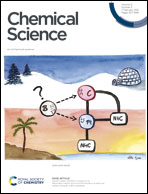Realizing high hydrogen evolution activity under visible light using narrow band gap organic photocatalysts†
Abstract
The design and synthesis of conjugated semiconducting polymers for photocatalytic hydrogen evolution have engendered intense recent interest. However, most reported organic polymer photocatalysts show a relatively broad band gap with weak light absorption ability in the visible light region, which commonly leads to a low photocatalytic activity under visible light. Herein, we synthesize three novel dithieno[3,2-b:2′,3′-d]thiophene-S,S-dioxide (DTDO) containing conjugated polymer photocatalysts by a facile C–H arylation coupling polymerization reaction. The resulting polymers show a broad visible light absorption range up to 700 nm and a narrow band gap down to 1.81 eV due to the introduction of the DTDO unit. Benefiting from the donor–acceptor polymer structure and the high content of the DTDO unit, the three-dimensional polymer PyDTDO-3 without the addition of a Pt co-catalyst shows an attractive photocatalytic hydrogen evolution rate of 16.32 mmol h−1 g−1 under visible light irradiation, which is much higher than that of most reported organic polymer photocatalysts under visible light.



 Please wait while we load your content...
Please wait while we load your content...